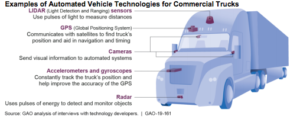Automated Trucking – Its Impact On the U.S. Workforce Is Uncertain
When the average person talks about vehicular automation, thoughts immediately turn to personal cars. Led by such high-profile companies as Tesla and ride-sharing company Uber, most automakers around the globe are actively pursuing automation technology ultimately focused on self-driving cars.
At DriverSource, we realize the same technology is reshaping the future of Trucking. And, like everyone who works in this industry, we are wondering…”what impact will automation have on the 1.9 million heavy and tractor-trailer truck drivers in the U.S. over the next decade?”
Current (and Future) Automation Technologies for Trucks
GPS, cameras, accelerometer and gyroscopes, and radar will soon become the “eyes” of all self-driving vehicles. LiDAR Sensors( Light Detection and Ranging) promise to constantly map a truck’s surroundings. While this futuristic technology may remind you of that popular children’s cartoon from the 80s – “The Jetsons”-, the reality is that automated features such as adaptive cruise control are already being used in some trucks.
Platooning is just one step in truck automation that is expected to boost fuel efficiency and safety for commercial fleets. A short-range wireless connection is used to link two or more trucks on a highway. The concept allows for the leader truck to set the speed and breaking of all trucks platooned in close formation behind it, utilizing the aerodynamic benefits of the truck ahead while reducing the risk of rear-end collisions and other accidents.
The Impact of Automation on the Trucking Workforce
While automation is already taking place in trucking, most of the changes are expected to take place in the next five to ten years. Progress is largely dependent on public perception of automated vehicles and government regulatory decisions. Most forms of automation envision the ongoing need for drivers to navigate urban environments. Also, even if platooning become commonplace on highways, drivers are still expected to be present in leader trucks.
Governmental Policies Regarding Automation Will Determine the Workforce Impact
“When will drivers’ presence in automated periods be required” is a question that the government will have to decide. It is a decision that will have a large impact on workforce numbers.
While current laws limit the numbers of hours that drivers can drive to 11 out of 14 hours, will this law still be enforced if drivers are simply present in an automated vehicle but not driving? Ultimately, the government has to decide whether automated trucking should be subject to the same regulations as human drivers.
The Department of Transportation (DOT) is holding listening sessions with the trucking industry to gather feedback for the rulemaking process. And, they are working will state agencies to prepare for workforce changes that may occur in areas where trucking jobs are prevalent in an effort to mitigate localized economic effects. The expectation is that some driver positions may go away while new, specialized skills will be required in the future.


